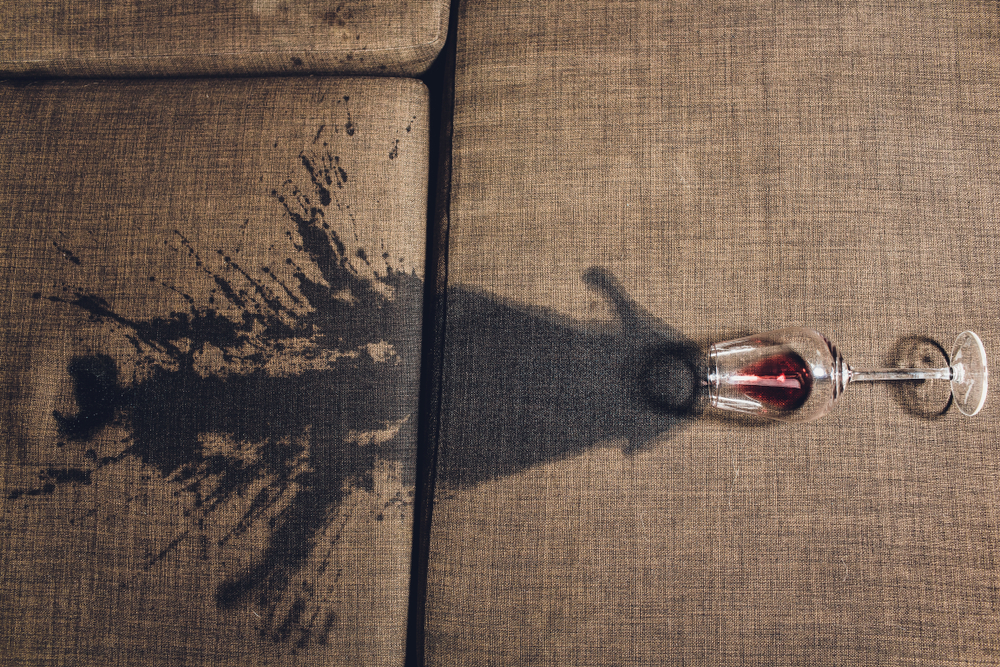The easiest and most effective way to clean and prevent stains is to act fast. As soon as something is spilled on your couch, you should try and blot it up and clean the affected area.
You should never attempt to rub the stain as this will cause it to spread and embed deeper into the fabric fibers.
The optimal removal method depends on the type of stain that you are dealing with. Each has its own stain remover and will need a slightly different approach.

General stain removal tips include working from the outside of the stain inwards, to avoid the stain bleeding and spreading further out.
You should look for the manufacturer’s care tag on your sofa. This is commonly found underneath one of the seat cushions. Check this for a cleaning code that will indicate the best cleaning instructions.
A “W” cleaning code means that you should use a water-based method. A good way to tackle the cleaning of fabrics like this is to combine some warm water with gentle dish soap. These sofas tend to be the easiest to clean, and can also hold up well to steam cleaning.
An “X” code indicates that the fabric is fairly delicate and must be handled with care. You should not use any solvents or water on the fabric, and can only vacuum the surface. If there is a stain on a sofa with this code, you should contact a professional upholstery cleaning service.
An “S” indicates that solvent-based cleaners can be used on the couch. Water and water-based cleaning solutions will leave watermarks on the fabric and so should not be used.
These couches require the use of dry-cleaningold-fashioned solvents, and the ideal one may be stated on the care label. You can purchase fabric solvent cleaners from most homeware stores.
A “WS” code means that you need to combine the use of solvent-based cleaners and water to lift stains. We recommend trying to use the solvents first before moving on to water.
Can sofa stains be removed?
Yes, there are many ways that you can remove stains from a sofa or couch. If you cannot remove the stain, this does not mean that it’s the end of the road. A great way to give your couch a new lease of life is to dye the entire cover.
Choose a dark color to cover up the stained areas, and by the time you are done, you will have a couch that looks brand new.
There are some other ways to lift stains that vary from the methods mentioned above. Be aware that they have the potential to damage your couch fabric and should always be spot tested first.
If the stain is from blood, you can combine half a liter of water with 1 ounce of table salt. Wet the stained area and blot with a clean cloth. Continue this process until the stain has lifted.
There are many fabric spot cleaning solutions available on the market. These can be very useful when treating smaller stains on your sofa. Again, it is important to check the instructions to ensure that you do not damage your sofa.
If your couch is made of leather, combine equal quantities of warm water and white vinegar. Wipe this solution over the surface of your sofa using a damp microfiber cloth. Ensure that you dry the couch fully once the solution has been wiped off.
Can you use bleach to clean a couch?
We do not recommend using bleach to clean your couch as a general rule. This is because bleach will draw the colors out of your couch cover. Unless your couch is white, this will lead to an unsightly and uneven finish.
By using bleach, you run the risk of making the couch look worse than it did with the stain. Many couch fabrics are also likely to become damaged through the use of bleach.
There are some fabrics that have been designed to be suitable for bleach cleaning. You should always check your couch’s care instructions provided by the manufacturer to be sure you will not damage the fabric.
If you are planning on using bleach as a stain remover or cleaning agent, you should perform a spot test first. This is where you apply the cleaning solution to an inconspicuous area of the fabric and allow it to work before cleaning.
This allows you to see how the bleach will interact with the fabric and means that you do not ruin your entire couch.
If you are planning to use bleach, you cannot pour it straight from the bottle onto your couch. You should dilute it with warm water in a ratio of 1:4. Bleach should only be used as a last resort in stain removal and is only really effective on highly colored stains.
How do you get black stains out of a couch?
Black stains are usually caused by soot or charcoal. This might be a problem that you are familiar with if you barbecue frequently, or if you have an old fashioned fireplace in your home.
The first step that you should take is to vacuum the surface of your couch to remove any loose dirt and debris. You should then grab a measuring jug and fill it with 500 ml of warm water. Add in 1 tablespoon of liquid laundry detergent and mix well to combine.
Grab a soft cloth and soak it in the solution. Use this to gently wipe the surface of the stain, taking care not to spread it further. Grab a dry cloth and use this to blot the newly damp area.
With a third, clean cloth, wipe over the affected area with plain water to remove any detergent residue. Use a piece of kitchen paper to blot away any remaining moisture.
If this does not remove the stain sufficiently, we strongly recommend contacting a professional upholstery cleaning company for further assistance.
